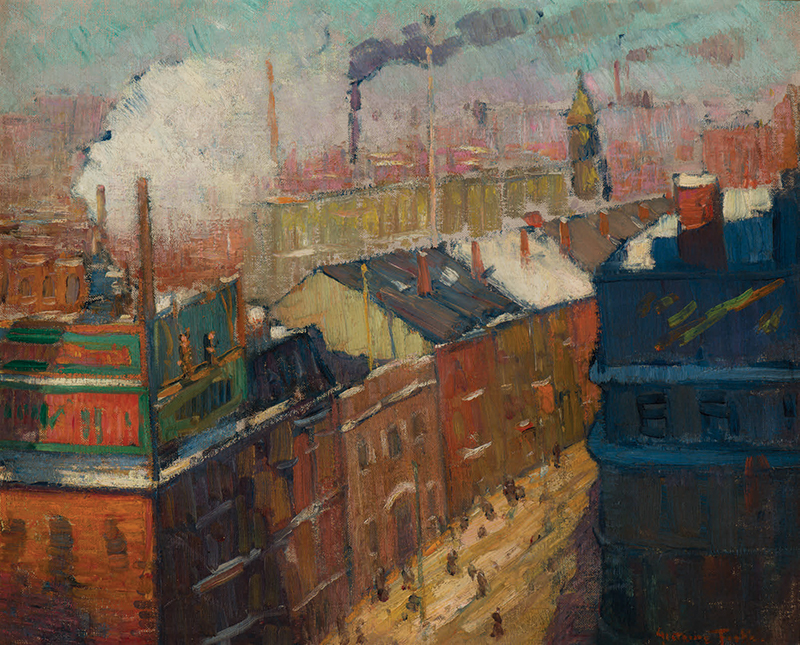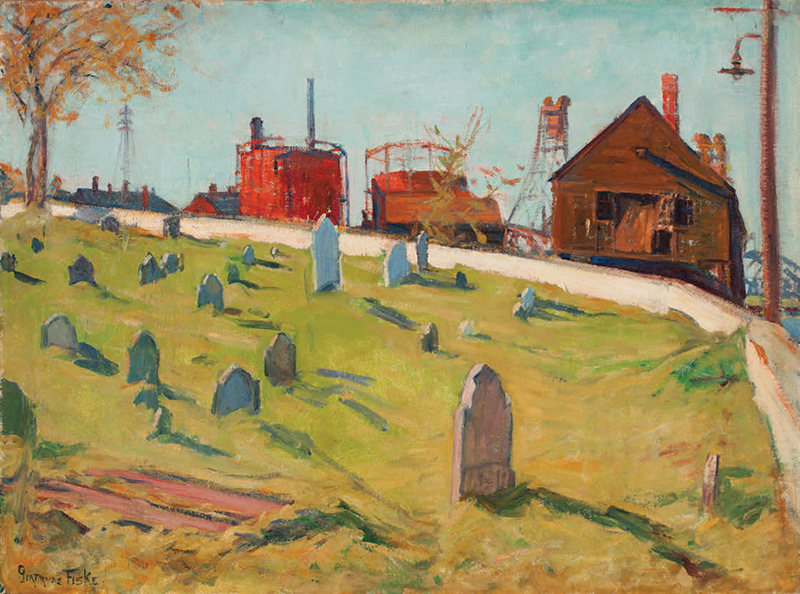
Cornhill 2 by Fiske, 1923. Oil on canvas, 17 by 21 inches. Private collection.
Mention by a noted Boston paintings dealer about an exhibition that could well have been expected at the Museum of Fine Arts, Boston, should send readers an hour north—to Portsmouth, New Hampshire, where Gertrude Fiske: American Master opens on April 6 at Discover Portsmouth, operated by the Portsmouth Historical Society (to September 30). Organized by Lainey McCartney, the show is a new look at the work of Fiske, who, McCartney says, “challenged established stereotypes for women with her extraordinary talent, dignity, and work ethic. Painting during a time when conservative traditions and social roles were firmly set for women, Fiske forged her own path.” We asked McCartney to set the scene for Fiske’s work and demonstrate her observations with some of Fiske’s paintings. She writes:
As a response to a rapidly growing industrial way of life and waves of immigration in the last quarter of the nineteenth century, elements of a new national consciousness arose in the United States and persisted to about 1940—and to some degree even today. Generally considered part of the colonial revival, these nativist sentiments, which found expression in architecture, decorative arts, paintings, and all types of material life, represented an effort to reclaim, in part, a sense of an earlier time in America. Boston was a significant hub of colonial revivalism, and the Boston School of Painting, led by Edmund C. Tarbell, is closely identified with the movement. Fiske, having been a full-time, seven-year student at the School of the Museum of Fine Arts, Boston, was trained in this aesthetic. What is so revealing of the kind of woman she was, however, is that, in the face of social convention and the strong direction of the Boston school and its more genteel mannerisms, she forged her own path. For instance, instead of removing signs of industry and technology from her paintings, Fiske was sure to include them. The central figure in her piece Wells, Maine, for example, is a line of utility poles, with a secondary electrical line running across the painting.

Portsmouth Burying Ground (or Old Portsmouth) by Gertrude Fiske (1878–1961), c. 1925. Oil on canvas, 20 1/2 by 27 1/2 inches. Private collection.
Portsmouth Burying Ground shows Portsmouth’s oldest cemetery, known as the Point of Graves, located on the banks of the Piscataqua River in the south end of town. A rough, working waterfront would have been an unseemly place to find a woman painting in the early 1920s. Yet Fiske did not shy away from the opportunity to paint the bright red gas tanks (gasometers) and the Sheafe warehouse (in its original location) as a backdrop to the ancient burial ground.
Yet another example of Fiske’s painting the unexpected can be found in Cornhill 2, depicting a busy street in Boston. At first glance, the smoke-churned atmosphere and urban density suggested by these old bricks creates a somber heaviness. Closer inspection, however, reveals a quiet intimacy and appreciation of place. This remarkable painting now serves as a historical record, as this quadrant of the city was demolished in the 1960s to create Government Center.
Fiske’s desire to document the landscape, regardless of how “pretty” it may or may not have been, gives us a window into her thoughts and values. Perhaps she found a parallel between the gains slowly being made by women, and the modern advancements moving America forward in this period.
The Fiske exhibition is complemented by two smaller shows at Discover Portsmouth, covered jointly in the exhibition catalogue, Gertrude Fiske: American Master, with Sisters of the Brush and Palette and Seacoast Masters Today by Lainey McCartney, with contributions by Carol Walker Aten and Richard M. Candee, and published by the Portsmouth Historical Society. portsmouthhistory.org.
